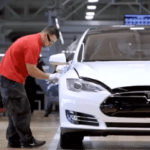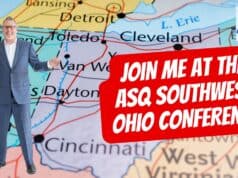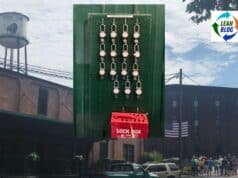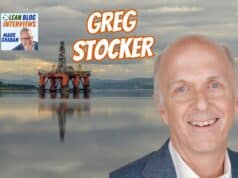 I was able to tour the NUMMI factory in 2005, which I really enjoyed (see my series of blog posts here). NUMMI was, of course, a joint venture between Toyota and GM (as John Shook talked about recently at the Lean Startup conference). NUMMI was shuttered a few years back when GM pulled out of the partnership, but the building was purchased and re-opened by Tesla.
I was able to tour the NUMMI factory in 2005, which I really enjoyed (see my series of blog posts here). NUMMI was, of course, a joint venture between Toyota and GM (as John Shook talked about recently at the Lean Startup conference). NUMMI was shuttered a few years back when GM pulled out of the partnership, but the building was purchased and re-opened by Tesla.
I haven't had a chance to go back to Fremont. Tesla has done public tours but another page on their site says they are not available at this time (October 2013). Thankfully, we have some video from Bloomberg and WIRED to give us a peek inside (via treehugger.com).
Here is the Bloomberg Video (link)
Gilbert Passin, VP of Manufacturing says the production rate is 500 cars per week. This is relatively low volume for a car factory. NUMMI was building 6000 cars per week with 4,700 employees. The WIRED video says there are 3,000 employees at Tesla. That's clearly a much lower productivity level and Tesla clearly has plans to increase production (they have to increase sales first). I wonder how many of the employees are “fixed” (the minimum number required to keep any factory open even building just one car) vs “variable”? It's clearly not all variable (nor would I expect it to be).
Passin says the costs are higher, doing the production in California, but they save money and have lower inventory and logistics costs by having everything in place. It's better than “having things scattered” all over the globe. That's the same strategy employed by Toyota here in San Antonio (with all of the suppliers and stamping, etc. done on site) and it was a similar strategy at the Range Rover factory that my wife and I got to tour in England last month (I'll blog about that soon).
Like Texas is doing with trucks in San Antonio, Tesla is building close to their customers (assuming Silicon Valley and California are a high sales market for them). I've seen one Tesla in a parking lot here in San Antonio, by the way.
The two videos talk about the 140 (or 160) robots used in the plant. The Bloomberg video shows how the robots do the body panel joining and the painting. The aluminum unrolling and stamping processes (fully automated until final inspection) are very similar to what we saw in the Range Rover factory. Tesla implies that the painting is all done by robots. The Range Rover plant had humans doing some of the painting, because they thought the quality was better in some applications to have people doing it.
Here are the WIRED videos:
Part 1:
Part 2:
I'm not surprised that a technology publication would fixate on the robots and automation. Tesla is not alone in using automation for welding and body riveting. Toyota has very automated welding lines. I remember the NUMMI people saying they had more human welding than a comparable GM plant.
It was the old GM strategy to try to automate everything — as much as possible. This was taken to the extreme of the late CEO Roger Smith‘s dreams of a fully-automated “lights out factory.” GM wasted hundreds of billions of dollars on automation (“robots painting robots,” lamented Dr. W. Edwards Deming about the failures). Toyota invested in people, as an alternative strategy.
That's why I was surprised to hear Tesla fixate so much on robots. They are “utilizing automation to the fullest” and they are “pushing the boundaries” of what robots can do. But it's more like GM than Toyota to want to be automating for the sake of automating. The second video talks about wanting to build the “most advanced factory.” Is that really the goal or is the “most effective factory” a better goal?
For example, the first WIRED video shows a robot installing seats into the car. This is often done by humans, with robotic assists and lift arms (including at Toyota, from my recollection of a recent tour). They show a windshield being installed by a robot (which I believe is also done at Toyota).
It's the “Lean” perspective (from Toyota) to use automation where it makes sense. If a job is unsafe for humans, it should be done by robots (in keeping with the “respect for people” principle. If a job can be done BETTER by robots, focusing on the customer and quality, then that's fine. In the second WIRED video, Passin talks about how robots are good at repeatability (they don't get tired, as was said in another Tesla video — but they do break down!), but humans “are more intelligent than robots” so they need to be used appropriately.
Passin talks about all of the great talent at nearby universities like Stanford and Berkeley. It should be noted that GM had no shortage of people from top engineering schools and top MBA programs. The real question is how you “take full advantage” of every employee's talents, not just the highly-educated ones.
The Tesla plant talks about being “very nimble” because their design engineers are on site. That's very Lean… I just hope the Tesla plant is not just in love with technology and that they are also fully developing and utilizing their people in a truly Lean style. Having a highly vertically-integrated value stream that's almost all onsite certainly leads to faster production. That's Lean.
I'd love to visit and ask questions about what sort of management system they are putting in place and what sort of culture they are trying to build – more like GM or more like Toyota? Passin, the VP of manufacturing, came from SpaceX (Tesla founder Elon Musk's other company), not NUMMI or Toyota.
Passin does talk about people in the second WIRED video – discussing painting the whole factory white because employees “want to feel at ease” and feel like they work in a “quality place.” I hope the management system and leadership style also makes them feel at ease…
Please scroll down (or click) to post a comment. Connect with me on LinkedIn.
Let’s build a culture of continuous improvement and psychological safety—together. If you're a leader aiming for lasting change (not just more projects), I help organizations:
- Engage people at all levels in sustainable improvement
- Shift from fear of mistakes to learning from them
- Apply Lean thinking in practical, people-centered ways
Interested in coaching or a keynote talk? Let’s talk.









Thanks for elaborate posting Mark on Tesla and the NUMMI legacy. Certainly there is always room for improvement, and lean is not done in one day.
However what strikes me most positively is the open mind of Tesla’s management team to share videos of the production inside so openly. I don’t know of any other car maker (besides Ford and BMW in Leipzig) that share this openness and transparency.
As soon as I visit the region I certainly will also go for a look to get a closer understanding of the processes done, and the management and leadership behind it.
Touching the point of robots – jobs in the paint shop and body shop of a car manufacturer certainly is no play for humans to play to their strengths, and capabilities. Easing “boring” and “dangerous” jobs to robots is from my point of the view the lean way to go, and free people to really tackle the bold challenges that always are around in a factory (as technology changes, see the BMW i series now being built in Leipzig where the initial infrastructure had been installed for the “normal” BMW combustion, and steel body automobile).
All the best and Happy New Year 2014
Ralf
Thanks for the comment, Ralf. It’s nice to see you!
You’re right that a Lean culture isn’t built in a day, but they could have had a huge head start if Tesla had hired a lot of associates, team leaders, and group leaders from NUMMI. Senior leaders set the tone and, as we’ve learned from the Wiremold example, new leaders can quickly destroy a Lean culture).
NUMMI was a UAW plant and Toyota famously hired back many of the former GM/UAW employees. Tesla is NOT a UAW plant (the UAW is trying to change that), so I wonder if they hired mostly new employees??
Starting pay was listed as $16 in a 2011 article, which is lower than most UAW wages (average NUMMI pay was $27 per Glassdoor.com, which seems accurate).
I’m not saying that they have to be unionized to practice “respect for people” but it’s interesting to see that they chose a different path there. I don’t blame Elon Musk for wanting a union-free factory… NUMMI was successful at union wages (but they had a higher volume).
If they have a “respect for engineering” culture (as John Hunter asked on Twitter), that only respects college graduates, they are not going to have a Lean culture, even given time.
Dangerous jobs (or those with poor ergonomics) should be automated. “Boring” jobs — that boredom can be addressed through frequent job rotation and by having everybody engaged in Kaizen – thinking about how to improve those boring jobs. As Norman Bodek teaches, one of the key Kaizen questions is to ask people how to make their work less boring.
Happy New Year!
Watching the first video, it makes sense to do the body shop welding with robots. Many years ago, GM lost a lawsuit where a drunk driver crashed into the back of a GM car at about 70 MPH, resulting in at least one death. While the crash would have likely been unsurvivable, particularly in a car of that period, a plaintiff attorney did some digging and discovered a weld was missing, and that the car had been built on the first day of deer hunting season, likely with an inexperienced worker doing the welding. (The 1st day of hunting season is now a UAW holiday).
Yeah, it makes sense to have robots do most welds because they can be done more accurately. The Range Rover plant body panels were riveted (and also used adhesive) instead of welding and I think that was 100% automated or pretty close.
It can be highly automated and still be a “Lean culture” that practices “respect for people” in their daily work.